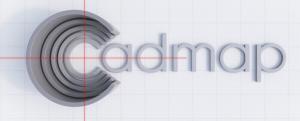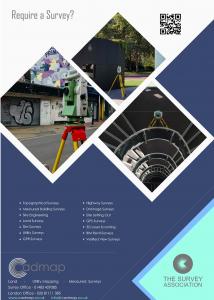Cadmap Ltd Opens a new office in Merton, London to expand workflow throughout the city
LONDON, LONDON, UNITED KINGDOM, September 14, 2023 /EINPresswire.com/ -- Cadmap have opened a new office based at Dalton House, 60 Windsor Avenue, London, United Kingdom, SW19 2RR. https://www.cadmap.co.uk/
Cadmap Ltd is a specialised geospatial survey company, fully accredited Land Surveyors & Building surveyors, specialising in measured building surveys london, topographical surveys surrey, level surveys, site engineering, site setting out, movement monitoring surveys, PAS128 utility mapping surveys, CCTV drainage surveys operating primarily in all the Home Counties, Greater London, London, Southampton, Portsmouth, Hampshire, Surrey, Sussex, Kent and Brighton, Guildford areas and the South of England. Land Surveyors Surrey.
What is a Topographical Survey?
A topographical survey, also known as a land survey or a topo survey, is a surveying method used to gather detailed information about the physical features and characteristics of a piece of land or a specific area. It involves measuring and mapping various natural and man-made features on the land's surface.
https://www.cadmap.co.uk/Surveying/LandTopographicalSurveys
The primary purpose of a topographical survey is to accurately represent the three-dimensional shape and configuration of the land, including its elevations, contours, and other significant features. The survey provides a comprehensive understanding of the existing terrain, which is crucial for planning, design, and construction of infrastructure, development projects, land management, and various other applications.
During a topographical survey, surveyors use a combination of traditional and modern surveying techniques and equipment. This can include the use of total stations, GPS (Global Positioning System) receivers, aerial photogrammetry, laser scanning, and other advanced instruments. https://cadmap.co.uk/
The surveyors traverse the land, taking precise measurements at various points to establish the elevation and position of key features such as buildings, roads, trees, rivers, fences, utility infrastructure, and any other relevant elements. The collected data is then processed and analyzed to generate accurate topographical maps, plans, and digital models, which typically include contour lines, spot heights, and other annotations to depict the land's characteristics.
https://www.cadmap.co.uk/Surveying/LandTopographicalSurveys
Topographical surveys are essential for a range of purposes, including urban planning, engineering design, construction projects, environmental assessments, land development, property boundary determination, and more. They provide critical information for decision-making, visualization, and analysis of the land, ensuring that any proposed development or modification takes into account the existing conditions and constraints of the site. https://cadmap.co.uk/ https://www.cadmap.co.uk/Surveying/LandTopographicalSurveys
What is a PAS128 Utility Survey?
A PAS128 Utility Survey is a type of survey that aims to locate and map underground utility infrastructure within a specified area. PAS128 stands for Publicly Available Specification 128, which is a specification developed by the British Standards Institution (BSI) for the detection, verification, and location of underground utilities.
The purpose of a PAS128 Utility Survey is to provide accurate and reliable information about the location, depth, and nature of buried utility services, such as water pipes, gas lines, electric cables, telecommunications networks, drainage systems, and other underground assets. This information is essential for planning and design purposes, ensuring safe excavation, reducing the risk of utility strikes, and minimizing costly delays or disruptions during construction projects.
A PAS128 Utility Survey typically involves the following steps:
Desktop Study: A thorough review of available records, as-built drawings, historical maps, and utility plans is conducted to gather existing information about the potential presence and location of utilities within the survey area.
Site Reconnaissance: Surveyors visit the site to visually identify visible utility features, such as manholes, valve covers, utility cabinets, and other surface-level indications of underground services. This helps in understanding the site context and identifying areas of potential utility presence. https://www.cadmap.co.uk/Surveying/PAS128UTILITYSURVEYS
Geophysical Survey: Various geophysical techniques are used to detect and locate underground utilities. These techniques can include Ground Penetrating Radar (GPR), electromagnetic induction (EMI) or electromagnetic locating (EML) devices, magnetic methods, and other specialized tools. These instruments help identify anomalies and subsurface features that may indicate the presence of utilities.
Utility Verification: Once potential utility features are identified through geophysical methods, further investigation and verification are conducted to confirm the type, size, depth, and condition of the utilities. This may involve manual digging, potholing, or other non-destructive techniques to expose and visually inspect the utility assets.
Data Processing and Reporting: The collected data from the PAS128 Utility Survey is processed, analyzed, and compiled into a comprehensive report or deliverables. The report provides detailed information about the identified utilities, including their location, depth, material, condition, and other relevant attributes.
PAS128 Utility Surveys are important for managing the risks associated with underground utilities, ensuring compliance with regulations, and promoting safe construction practices. They help project teams make informed decisions, plan excavation activities, and mitigate the potential risks of utility strikes, ultimately improving project efficiency and reducing costs. https://www.cadmap.co.uk/Surveying/PAS128UTILITYSURVEYS
Cadmap undertake GPR utility surveys in London. GPR Utility surveys in Brighton. GPR Utility Surveys in Southampton and Portsmouth. GPR Utility Surveys in Surrey. https://www.cadmap.co.uk/Surveying/PAS128UTILITYSURVEYS
What are the various levels of PAS 128 surveys?
The PAS 128 standard takes a hierarchical approach to survey types.
PAS 128 Level A – Underground utilities are observed, excavated or exposed.
PAS 128 Level B – Underground utilities are detected by geophysical techniques. For example, Electromagnetic Location (EML) survey and/or Ground Penetrating Radar (GPR).
PAS 128 Level C – Utility records are validated by visual inspection.
PAS 128 Level D – Desktop utility record search.
https://www.cadmap.co.uk/Surveying/PAS128UTILITYSURVEYS
Cadmap Ltd is a specialised geospatial survey company, fully accredited Land Surveyors & Building surveyors, specialising in measured building surveys london, topographical surveys surrey, level surveys, site engineering, site setting out, movement monitoring surveys, PAS128 utility mapping surveys, CCTV drainage surveys operating primarily in all the Home Counties, Greater London, London, Southampton, Portsmouth, Hampshire, Surrey, Sussex, Kent and Brighton, Guildford areas and the South of England. Land Surveyors Surrey.
What is a Topographical Survey?
A topographical survey, also known as a land survey or a topo survey, is a surveying method used to gather detailed information about the physical features and characteristics of a piece of land or a specific area. It involves measuring and mapping various natural and man-made features on the land's surface.
https://www.cadmap.co.uk/Surveying/LandTopographicalSurveys
The primary purpose of a topographical survey is to accurately represent the three-dimensional shape and configuration of the land, including its elevations, contours, and other significant features. The survey provides a comprehensive understanding of the existing terrain, which is crucial for planning, design, and construction of infrastructure, development projects, land management, and various other applications.
During a topographical survey, surveyors use a combination of traditional and modern surveying techniques and equipment. This can include the use of total stations, GPS (Global Positioning System) receivers, aerial photogrammetry, laser scanning, and other advanced instruments. https://cadmap.co.uk/
The surveyors traverse the land, taking precise measurements at various points to establish the elevation and position of key features such as buildings, roads, trees, rivers, fences, utility infrastructure, and any other relevant elements. The collected data is then processed and analyzed to generate accurate topographical maps, plans, and digital models, which typically include contour lines, spot heights, and other annotations to depict the land's characteristics.
https://www.cadmap.co.uk/Surveying/LandTopographicalSurveys
Topographical surveys are essential for a range of purposes, including urban planning, engineering design, construction projects, environmental assessments, land development, property boundary determination, and more. They provide critical information for decision-making, visualization, and analysis of the land, ensuring that any proposed development or modification takes into account the existing conditions and constraints of the site. https://cadmap.co.uk/ https://www.cadmap.co.uk/Surveying/LandTopographicalSurveys
What is a PAS128 Utility Survey?
A PAS128 Utility Survey is a type of survey that aims to locate and map underground utility infrastructure within a specified area. PAS128 stands for Publicly Available Specification 128, which is a specification developed by the British Standards Institution (BSI) for the detection, verification, and location of underground utilities.
The purpose of a PAS128 Utility Survey is to provide accurate and reliable information about the location, depth, and nature of buried utility services, such as water pipes, gas lines, electric cables, telecommunications networks, drainage systems, and other underground assets. This information is essential for planning and design purposes, ensuring safe excavation, reducing the risk of utility strikes, and minimizing costly delays or disruptions during construction projects.
A PAS128 Utility Survey typically involves the following steps:
Desktop Study: A thorough review of available records, as-built drawings, historical maps, and utility plans is conducted to gather existing information about the potential presence and location of utilities within the survey area.
Site Reconnaissance: Surveyors visit the site to visually identify visible utility features, such as manholes, valve covers, utility cabinets, and other surface-level indications of underground services. This helps in understanding the site context and identifying areas of potential utility presence. https://www.cadmap.co.uk/Surveying/PAS128UTILITYSURVEYS
Geophysical Survey: Various geophysical techniques are used to detect and locate underground utilities. These techniques can include Ground Penetrating Radar (GPR), electromagnetic induction (EMI) or electromagnetic locating (EML) devices, magnetic methods, and other specialized tools. These instruments help identify anomalies and subsurface features that may indicate the presence of utilities.
Utility Verification: Once potential utility features are identified through geophysical methods, further investigation and verification are conducted to confirm the type, size, depth, and condition of the utilities. This may involve manual digging, potholing, or other non-destructive techniques to expose and visually inspect the utility assets.
Data Processing and Reporting: The collected data from the PAS128 Utility Survey is processed, analyzed, and compiled into a comprehensive report or deliverables. The report provides detailed information about the identified utilities, including their location, depth, material, condition, and other relevant attributes.
PAS128 Utility Surveys are important for managing the risks associated with underground utilities, ensuring compliance with regulations, and promoting safe construction practices. They help project teams make informed decisions, plan excavation activities, and mitigate the potential risks of utility strikes, ultimately improving project efficiency and reducing costs. https://www.cadmap.co.uk/Surveying/PAS128UTILITYSURVEYS
Cadmap undertake GPR utility surveys in London. GPR Utility surveys in Brighton. GPR Utility Surveys in Southampton and Portsmouth. GPR Utility Surveys in Surrey. https://www.cadmap.co.uk/Surveying/PAS128UTILITYSURVEYS
What are the various levels of PAS 128 surveys?
The PAS 128 standard takes a hierarchical approach to survey types.
PAS 128 Level A – Underground utilities are observed, excavated or exposed.
PAS 128 Level B – Underground utilities are detected by geophysical techniques. For example, Electromagnetic Location (EML) survey and/or Ground Penetrating Radar (GPR).
PAS 128 Level C – Utility records are validated by visual inspection.
PAS 128 Level D – Desktop utility record search.
https://www.cadmap.co.uk/Surveying/PAS128UTILITYSURVEYS
Mike Brett
Cadmap Limited
01483429385
email us here
Visit us on social media:
Facebook
X
LinkedIn
Instagram
YouTube
Legal Disclaimer:
EIN Presswire provides this news content "as is" without warranty of any kind. We do not accept any responsibility or liability for the accuracy, content, images, videos, licenses, completeness, legality, or reliability of the information contained in this article. If you have any complaints or copyright issues related to this article, kindly contact the author above.



